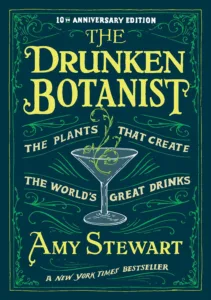This fascinating, go-to text about the plants that make our drinks is the ideal gift book for every cocktail aficionado, the perfect drinks book for every plant-lover.
In The Drunken Botanist, Amy Stewart explores the dizzying array of herbs, flowers, trees, fruits, and fungi that humans have, through ingenuity, inspiration, and sheer desperation, contrived to transform into alcohol over the centuries.
Of all the extraordinary and obscure plants that have been fermented and distilled, a few are dangerous, some are downright bizarre, and one is as ancient as dinosaurs—but each represents a unique cultural contribution to our global drinking traditions and our history.
This charming concoction of biology, chemistry, history, etymology, and mixology—with delightful drawings, tasty cocktail recipes, and fun factoids throughout—will make you the most popular guest at any cocktail party.



